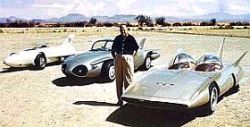1956 Firebird II
In 1956, a more refined four-passenger Firebird II
(center) turbine-powered car, which
featured the first regenerative gas turbine, was introduced. Its
exterior bodywork was made entirely of titanium.
The engine output was 200 hp (150 kW), and to solve the exhaust heat problem it
was fed through a regenerative system, which allowed the entire engine to
operate at nearly 1,000 °F (538 °C) cooler, and also power the accessories
such as air conditioning and power steering.
Another innovation on the car was the first use of four wheel disc brakes,
with a fully independent suspension, as well as a sophisticated guidance system which was
intended to be used with "the highway of the future", where an electrical wire
would be embedded into a roadway to send signals that would help guide future
cars and avoid accidents.
